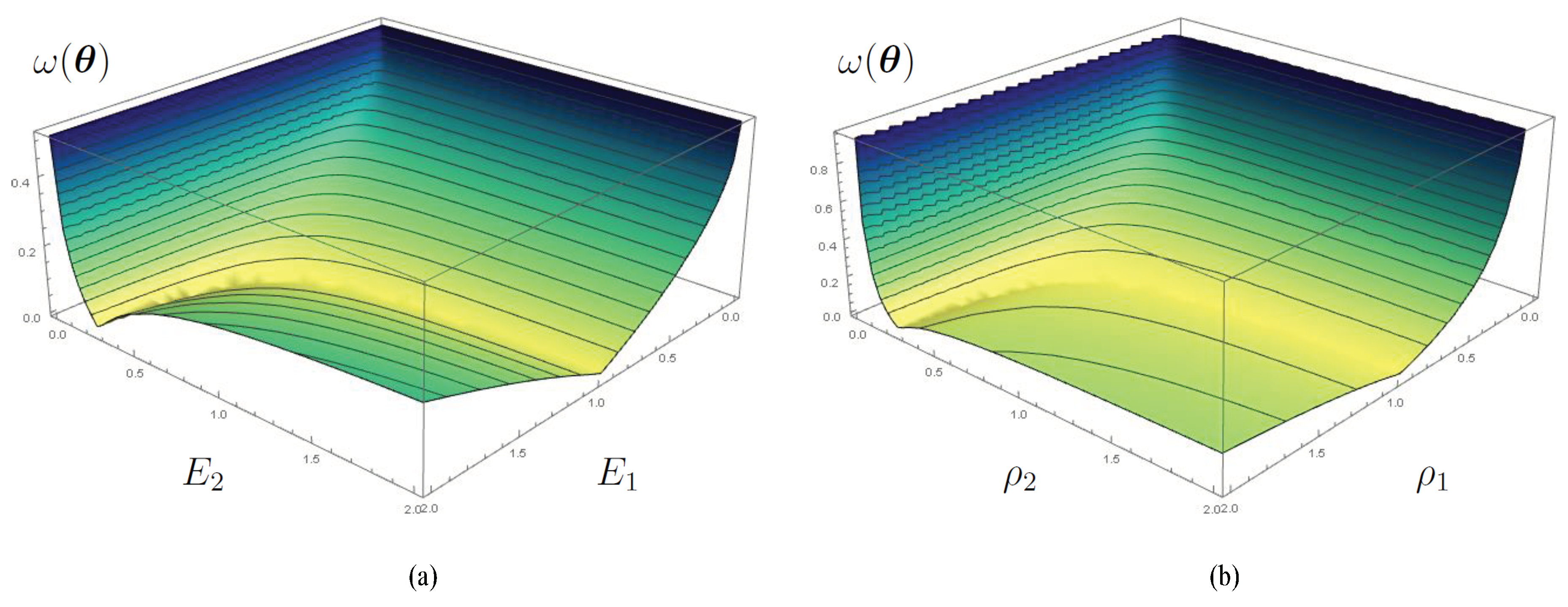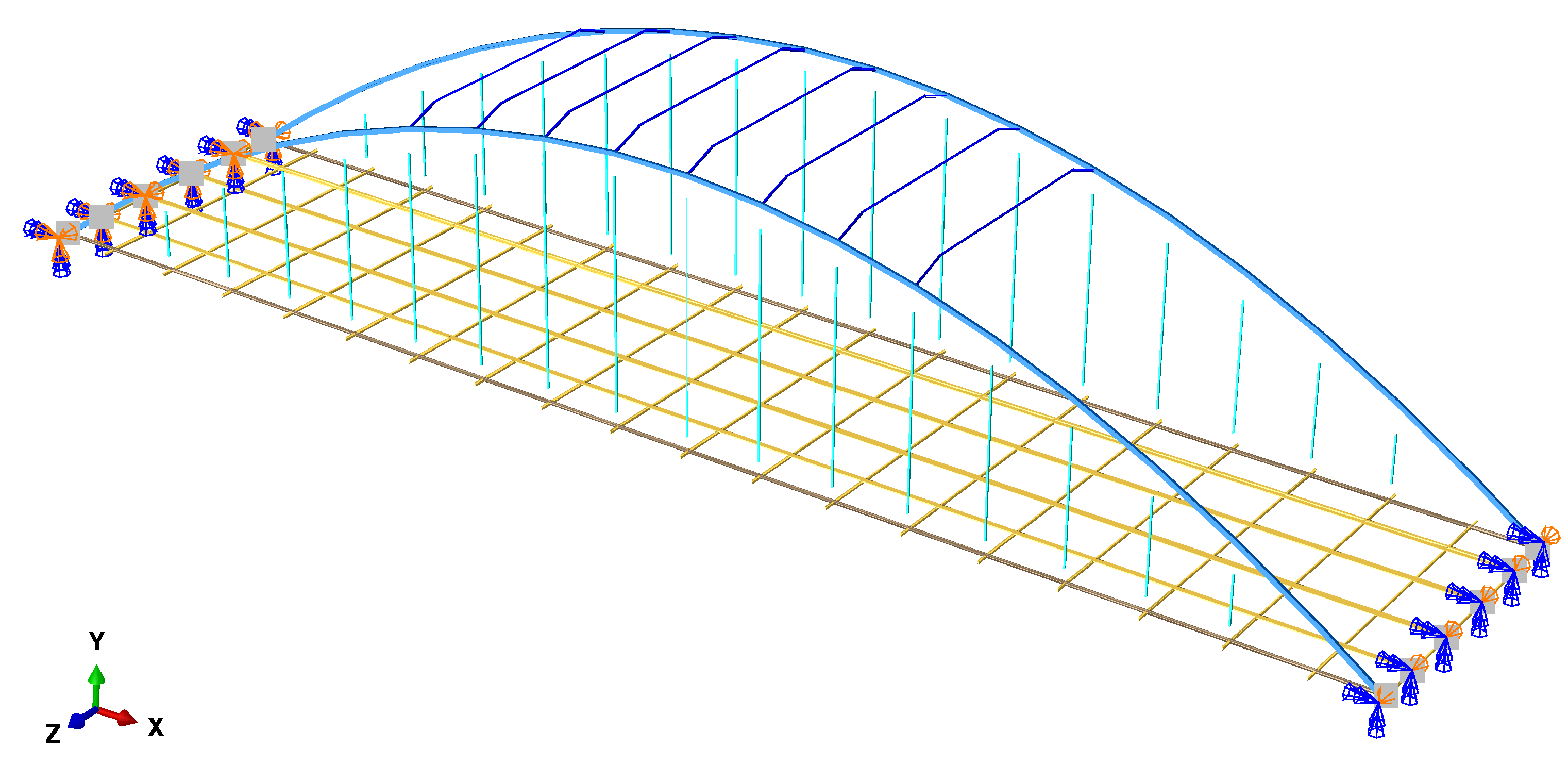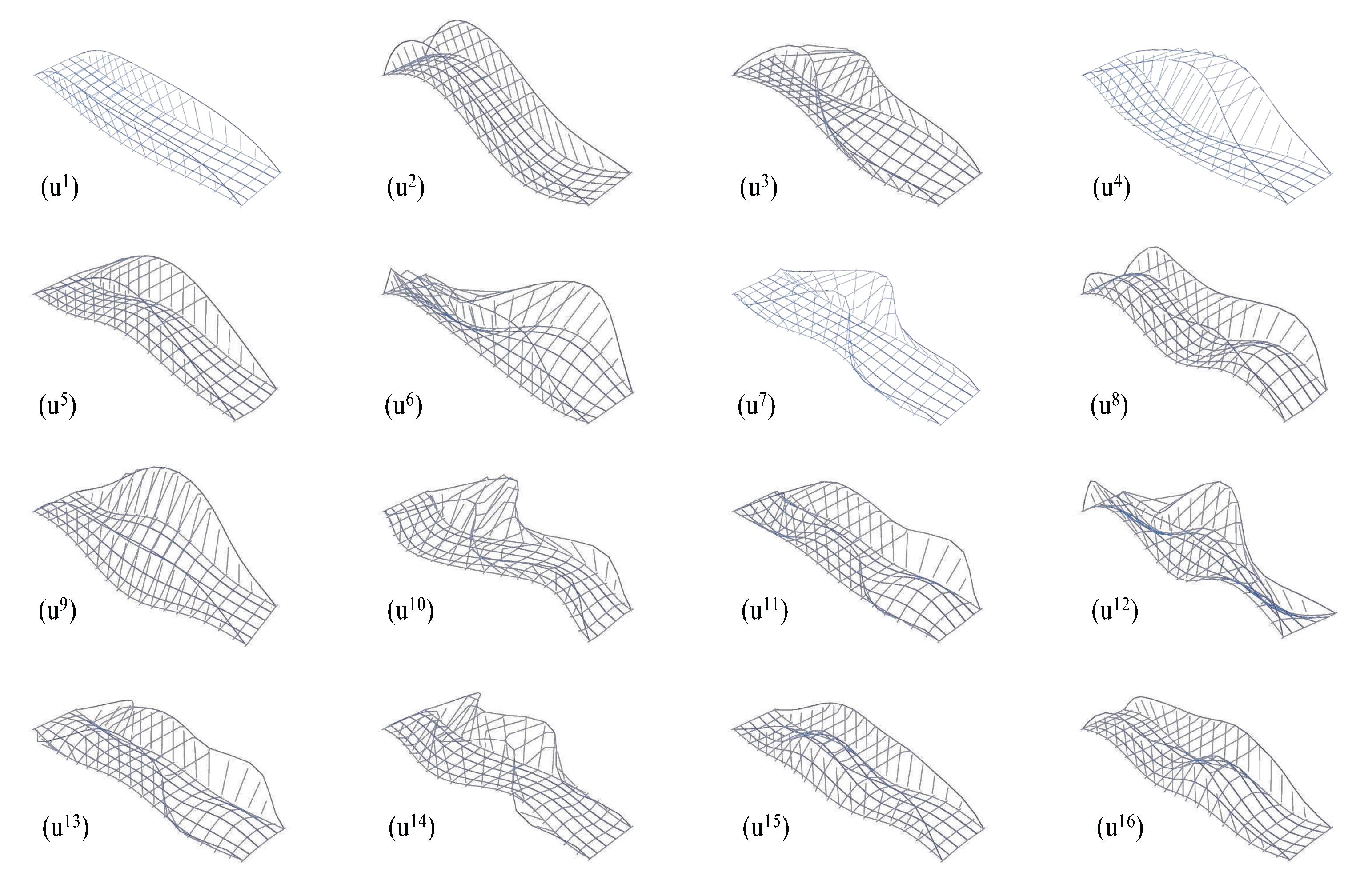Submitted:
14 July 2023
Posted:
18 July 2023
You are already at the latest version
Abstract
Keywords:
1. Introduction
- Selection of the parameters to be estimated in the investigated problem, namely choice of the sought quantities to be identified, toward assessment and calibration of the specific behaviour and model.
- Design of the experiment, as the best suitable experimental procedure to collect response data as source of information for a subsequent identification phase.
- Test simulation, by computational modelling, to effectively reproduce the experimental phenomena, in a reliable manner, to evaluate numerical counterparts of experimental measurements.
- Definition of a feasible “search domain”, namely of a constrained space of the underlying system parameters, with limits possibly suggested by experts or guidelines, to be adopted within the identification procedure.
- Sensitivity analysis (see, e.g., [8]) of the investigated problem, with respect to the sought parameters, in order to efficiently understand the specific influence of the selected parameters (possibly, to be reduced) on the system behaviour and, specifically, on the observed quantities.
- Formulation of an appropriate “discrepancy function”, to be minimised, as a scalar norm between measured and computed quantities, therefore forming a function of the input sought parameters, possibly also accounting for sources of uncertainty.
- Selection and implementation of a minimisation algorithm, in order to handle, in a robust and efficient manner, the foreseen optimisation problem of inverse identification, selecting for instance among mathematical programming methods, evolutive methods or artificial intelligence methods.
- Validation and accuracy checks, developed to test and confirm the effectiveness of the specific devised approach, either on pseudo–experimental (necessary validation condition) or real experimental measurement data.
2. Parameter Identification Relying on Dynamic Measurements: Problem Setup
- The adoption of modal properties, as a unique source of measurement data, intrinsically brings in a “non–well posedness” condition, in terms of multiple “realisations”, in terms of ratios between stiffness and mass properties of a structural system, namely leading to the identification of the correlated parameters, as also shown by the “valley” of minima in the discrepancy function plot for a two–dimensional parameter space (see Figure 1).
- Uniqueness of the optimisation problem may be found, in a two–dimensional parameter space, fixing either one of the two constitutive parameters or their ratio. Therefore, in a practical application case study, additional evaluations or measurements shall be required, to possibly estimate specific mechanical parameters at the local scale (e.g., by material testing) or from global scale measurements devised by experimentally controlled static or dynamic testing of the structure.
- The enlargement of the parameter space size further exhibits a correlation between parameters, namely a possible balancing effects or multiple mathematically equivalent “realisations”. Such an observation is graphically depicted in Figure 2, where three–dimensional cross sections of the discrepancy function, analysed in a four–dimensional parameter space, reveal possible “valleys” of minima, also in terms of ratios between stiffness or mass density parameters (Figure 2a and Figure 2b, respectively).
- Therefore, a robust Inverse Analysis procedure shall require complemented measurement data, suitable to assess the behaviour of diverse structural components and capable to estimate, possibly in a sequential procedure, both stiffness and mass density properties, for instance also considering experimental static or dynamic loading tests on the structure.
3. Optimised Structural Modelling on the Case Study of a Historical Concrete Bridge
- Among the selected modelling parameters, for material and boundary condition standpoints, with reference to the selected measurements and discrepancy function, a major role is assumed by nine mechanical constitutive parameters, namely Young’s moduli () and mass densities () of the structural components, as pointed out by previous sensitivity analyses in [37].
- Global property measurement, such as for natural frequency, may suffer reduced sensitivity effects, causing significant difficulties in specific parameter identification. This particular condition can be observed from the numerical results in Table 2, third and fourth columns, where the global frequency variation is computed for a 30% range variation on parabolic arches elastic modulus () and mass density (), with variation gain on the results approximately reduced by one order of magnitude.
- According to the previous point, in order to ensure a robust and reliable parameter identification procedure, specific requirements are expected in the measuring stages, namely significantly reducing noise effects and providing complete structural observations, possibly complemented by local detailing measurements and estimations.
- As a complementary global source of measurement information, vibration modes can carry similar observations, as the above–mentioned for natural frequencies, both on sensitivity effects and complete measurement requirements. As an example, the results reported in Figure 7 graphically represent the numerical results for the second vibration mode of the bridge at the base configuration and for a 30% range variation of various specific parameters, without, however, structurally meaningful mode shape variations.
- The effect of boundary conditions on the mode shapes and natural frequencies appears to be less sensitive with respect to material parameters of bridge structural components (see, also, sensitivity analysis in [37]). However, the influence of mechanical parameters of elastic boundary conditions can rule a contribution approximately of one order of magnitude lower, though not negligible on a global scale structural behaviour (see, for an example, Table 2, fifth column). Therefore, particular attention is required in setting numerical model definition also regarding the boundary conditions, in order to produce a reliable numerical instrument, avoiding biased parameter fitting, in Inverse Analysis methodology for structural assessment and diagnosis.
4. Conclusions
Acknowledgments
References
- A. Tarantola, Inverse Problem Theory. Siam, 2005. [CrossRef]
- R.C. Aster, B. Bochers, C.H. Thurber, Parameter Estimation and Inverse Analysis. Elsevier, 2013.
- H.D. Bui, Inverse Problems in the Mechanics of Materials: An Introduction. CRC Press, 1994.
- Z. Mróz, G.E. Stavroulakis eds., Parameter Identification of Materials and Structures. Springer, 2005.
- V. Buljak, Inverse Analysis with Model Reduction. Springer, 2012. [CrossRef]
- T. Garbowski, Stochastic model reduction applied to inverse analysis. J.P.M. de Almeida, P. Díez, C. Tiago, N. Parés eds. VI International Conference on Adaptive Modeling and Simulation (ADMOS 2013), Lisbon, Portugal, June 3-5, 2013.
- V. Buljak, G. Cocchetti, A. Cornaggia, T. Garbowski, G. Maier, G. Novati, Materials Mechanical Characterizations and Structural Diagnoses by Inverse Analyses. G.Z. Voyiadjis ed. Handbook of Damage Mechanics, Springer, 619–642, 2015.
- M. Kleiber, H. Antúnez, T.D. Hien, P. Kowalczyk, Parameter Sensitivity in Nonlinear Mechanics. Wiley, 1997.
- M. Bocciarelli, V. Buljak, C.K.S. Moy, S.P. Ringer, G. Ranzi, An inverse analysis approach based on a POD direct model for the mechanical characterization of metallic materials. Computational Materials Science, 95, 302–308, 2014. [CrossRef]
- F. Arizzi, E. Rizzi, Elastoplastic parameter identification by simulation of static and dynamic indentation tests. Modelling and Simulation in Materials Science and Engineering, 22, 035017, 2014. [CrossRef]
- V. Buljak, G. Cocchetti, A. Cornaggia, G. Maier, Assessment of residual stresses and mechanical characterization of materials by “hole drilling” and indentation tests combined and by inverse analysis. Mechanics Research Communications, 68, 18–24, 2015. [CrossRef]
- V. Buljak, G. Cocchetti, A. Cornaggia, G. Maier, Estimation of residual stresses by inverse analysis based on experimental data from sample removal for “small punch” tests. Engineering Structures, 136, 77–86, 2017. [CrossRef]
- V. Buljak, G. Cocchetti, A. Cornaggia, G. Maier, Parameter identification in elastoplastic material models by Small Punch Tests and inverse analysis with model reduction. Meccanica, 53, 3815–3829, 2018. [CrossRef]
- G. Cocchetti, M.R. Mahini, G. Maier, Mechanical characterization of foils with compression in their planes. Mechanics of Advanced Materials and Structures, 21, 853–870, 2014. [CrossRef]
- V. Buljak, S. Bavier–Romero, A. Kallel, Calibration of Drucker–Prager cap constitutive model for ceramic powder compaction through inverse analysis. Materials, 14, 4044, 2021.
- K. Zaborowicz, T. Garbowski, B. Biedziak, M. Zaborowicz, Robust estimation of the chronological age of children and adolescents using tooth geometry indicators and POD–GP. International Journal of Environmental Research and Public Health, 19, 2952, 2022. [CrossRef]
- T. Garbowski, G. Maier, G. Novati, Diagnosis of concrete dams by flat–jack tests and inverse analyses based on proper orthogonal decomposition. Journal of Mechanics of Materials and Structures, 6, 181–202, 2011. [CrossRef]
- T. Gajewski, T. Garbowski, Calibration of concrete parameters based on digital image correlation and inverse analysis. Archives of Civil and Mechanical Engineering, 14, 170–180, 2014. [CrossRef]
- D. Ribeiro, R. Calçada, R. Delgado, M. Brehm, V. Zabel, Finite element model updating of a bowstring–arch railway bridge based on experimental modal parameters. Engineering Structures, 40, 413–435, 2012. [CrossRef]
- C. Bendon, M. Dilena, A. Morassi, Ambient vibration testing and structural identification of a cable–stayed bridge. Meccanica, 51, 2777–2796, 2016.
- T. Garbowski, A. Pożarycki, Multi–level backcalculation algorithm for robust determination of pavement layers parameters. Inverse Problems in Science and Engineering, 25, 674–693, 2017. [CrossRef]
- B. Miller, Application of neural networks for structure updating. Computer Assisted Mechanics and Engineering Sciences, 18, 191–203, 2011.
- F. Shabbir, P. Omenzetter, Model updating using genetic algorithms with sequential technique. Engineering Structures, 120, 166–182, 2016. [CrossRef]
- M. Crognale, V. Gattulli, A. Paolone, F. Potenza, A damage identification procedure for steel truss. A. Carcaterra, A. Paolone, G. Graziani eds. Proceedings of XXIV AIMETA Conference 2019 (AIMETA 2019), Roma, Italy, September 15-19, 2020.
- J.E. Mottershead, M.I. Friswell, Model updating in structural dynamics: A survey. Journal of Sound and Vibration, 167, 347–375, 1993. [CrossRef]
- E. Reynders, System identification methods for (Operational) Modal Analysis: Review and comparison. Archives of Computational Methods in Engineering, 19, 51–124, 2012. [CrossRef]
- C. Rainieri, G. Fabbrocino, Operational Modal Analysis of Civil Engineering Structures. Springer, 2014.
- F. Pioldi, R. Ferrari, E. Rizzi, Output–only modal dynamic identification of frames by a refined FDD algorithm at seismic input and high damping. Mechanical Systems and Signal Processing, 68–69, 265–291, 2016. [CrossRef]
- F. Pioldi, R. Ferrari, E. Rizzi, Earthquake structural modal estimates of multi–storey frames by a refined Frequency Domain Decomposition algorithm. JVC/Journal of Vibration and Control, 23, 2037–2063, 2017. [CrossRef]
- F. Pioldi, R. Ferrari, E. Rizzi, Seismic FDD modal identification and monitoring of building properties from real strong–motion structural response signals. Structural Control and Health Monitoring, 24, e1982, 2017. [CrossRef]
- R. Cardoso, A. Cury, F. Barbosa, A robust methodology for modal parameters estimation applied to SHM. Mechanical Systems and Signal Processing, 95, 24–41, 2017. [CrossRef]
- L. Santarella, E. Miozzi, Ponti Italiani in Cemento Armato (in Italian). Hoepli, 1948.
- R. Ferrari, D. Froio, E. Chatzi, C. Gentile, F. Pioldi, E. Rizzi, Experimental and numerical investigations for the structural characterization of a historic RC arch bridge. M. Papadrakakis, V. Papadopoulos, V. Plevris eds. 5th ECCOMAS Thematic Conference on Computational Methods in Structural Dynamics and Earthquake Engineering, Crete Island, Greece, May 25-27, 2015. [CrossRef]
- R. Ferrari, F. Pioldi, E. Rizzi, C. Gentile, E. Chatzi, R. Klis, E. Serantoni, A. Wieser, Heterogeneous sensor fusion for reducing uncertainty in structural health monitoring. M. Papadrakakis, V. Papadopoulos, G. Stefanou eds. 1st ECCOMAS Thematic Conference on Uncertainty Quantification in Computational Sciences and Engineering (UNCECOMP 2015), Crete Island, Greece, May 25-27, 2015.
- R. Ferrari, F. Pioldi, E. Rizzi, C. Gentile, E. Chatzi, E. Serantoni, A. Wieser, Fusion of wireless and non-contact technologies for the dynamic testing of a historic RC bridge. Measurement Science and Technology, 27, 124014, 2016. [CrossRef]
- A. Cornaggia, R. Ferrari, M. Zola, E. Rizzi, C. Gentile, Signal processing methodology of response data from a historical arch bridge toward reliable modal identification. Infrastructures, 7, 74, 2022. [CrossRef]
- R. Ferrari, D. Froio, E. Rizzi, C. Gentile, E. Chatzi, Model updating of a historic concrete bridge by sensitivity and global optimization–based Latin hypercube sampling. Engineering Structures, 1, 139–160, 2019. [CrossRef]
- G. Zonno, C. Gentile, Assessment of similar reinforced concrete arch bridges by Operational Modal Analysis and model updating. Lecture Notes in Civil Engineering, 156, 853–868, 2021. [CrossRef]
- T. Garbowski, G. Cocchetti, A. Cornaggia, R. Ferrari, E. Rizzi, Inverse analysis investigation by Gaussian Processes optimisation of a historical concrete bridge relying on dynamic modal measurements. M. Papadrakakis, M. Fragiadakis eds. 9th ECCOMAS Thematic Conference on Computational Methods in Structural Dynamics and Earthquake Engineering (COMPDYN 2023), Athens, Greece, June 12-14, 2023.
- R.W. Clough, J. Penzien, Dynamics of Structures. Computer & Structures, Inc., 1995.
- A.K. Chopra, Dynamics of Structures. Prentice Hall, 2012.
- C.Y. Wang, C.M. Wang, Structural vibration. CRC Press, 2014.
- N.J. Taleb, E.W. Suppiger, Vibration of stepped beams. Journal of the Aerospace Sciences, 28, 295–298, 1961.
- S.K. Jang, C.W. Bert, Free vibration of stepped beams: exact and numerical solutions. Journal of Sound and Vibration, 130, 342–346, 1989. [CrossRef]







| Parameter | Lower | Upper | Reference |
|---|---|---|---|
| bound | bound | value | |
| Deck elastic modulus, [GPa] | 24.4 | 45.4 | 34.9 |
| Main longitudinal girders elastic modulus, [GPa] | 24.4 | 45.4 | 34.9 |
| Parabolic arches elastic modulus, [GPa] | 25.0 | 46.4 | 35.7 |
| Hangers elastic modulus, [GPa] | 25.0 | 46.4 | 35.7 |
| Upper transverse beams elastic modulus, [GPa] | 25.0 | 46.4 | 35.7 |
| Deck mass density, [kg/m3] | 1710 | 3170 | 2440 |
| Main longitudinal girders mass density, [kg/m3] | 1710 | 3170 | 2440 |
| Parabolic arches mass density, [kg/m3] | 1710 | 3170 | 2440 |
| Hangers mass density, [kg/m3] | 1710 | 3170 | 2440 |
| Upper transverse beams mass density, [kg/m3] | 1710 | 3170 | 2440 |
| I–support translational (x–axis) spring stiffness, [kN/m] | 10−7 | 10−3 | 10−5 |
| I–support translational (y–axis) spring stiffness, [kN/m] | 108 | 1012 | 1010 |
| I–support rotational spring stiffness, [kNm] | 10−7 | 10−3 | 10−5 |
| II–support rotational spring stiffness, [kNm] | 10−7 | 10−3 | 10−5 |
| Frequency [Hz] | Reference parameter values | +30% | +30% | +30% |
|---|---|---|---|---|
| 2.5312 | +1.28% | −4.22% | +0.07% | |
| 3.7908 | +3.53% | −2.91% | +0.01% | |
| 3.9781 | +4.41% | −5.30% | +0.06% | |
| 5.4889 | +1.52% | −1.42% | +0.08% | |
| 5.8677 | +3.72% | −1.77% | +0.30% | |
| 6.4903 | +1.63% | −4.26% | +0.00% | |
| 7.7809 | +4.66% | −6.00% | +0.18% | |
| 7.8392 | +4.08% | −2.36% | +0.15% | |
| 8.8131 | +2.41% | −2.80% | +0.16% | |
| 10.311 | +1.84% | −5.40% | +0.01% | |
| 10.325 | +4.03% | −2.99% | +0.10% | |
| 10.672 | +3.73% | −4.45% | +0.28% | |
| 10.888 | +4.45% | −5.72% | +0.23% | |
| 12.139 | +1.38% | −4.10% | +0.06% | |
| 12.160 | +4.05% | −1.55% | +0.01% | |
| 12.490 | +2.43% | −1.46% | +0.09% |
Disclaimer/Publisher’s Note: The statements, opinions and data contained in all publications are solely those of the individual author(s) and contributor(s) and not of MDPI and/or the editor(s). MDPI and/or the editor(s) disclaim responsibility for any injury to people or property resulting from any ideas, methods, instructions or products referred to in the content. |
© 2023 by the authors. Licensee MDPI, Basel, Switzerland. This article is an open access article distributed under the terms and conditions of the Creative Commons Attribution (CC BY) license (http://creativecommons.org/licenses/by/4.0/).





